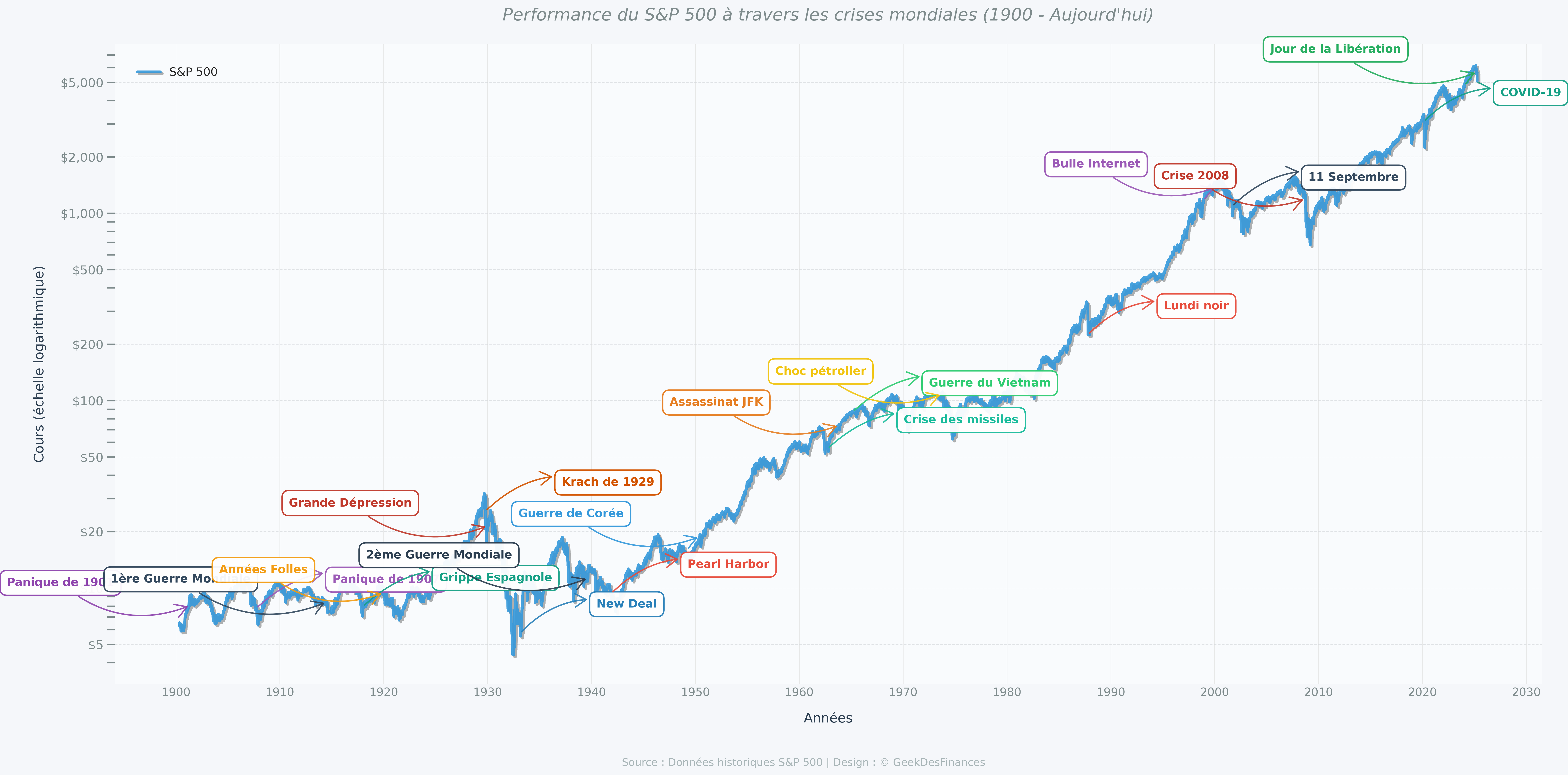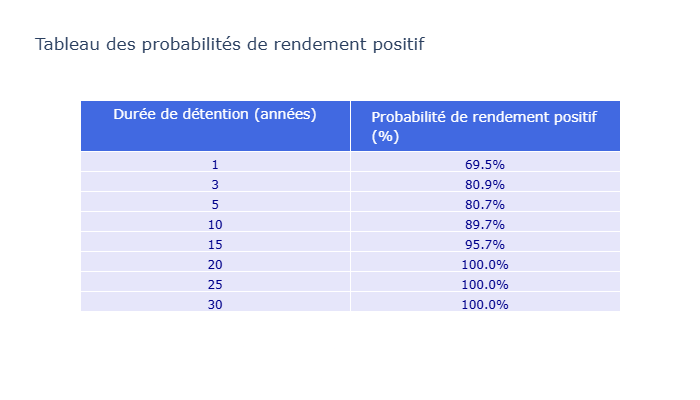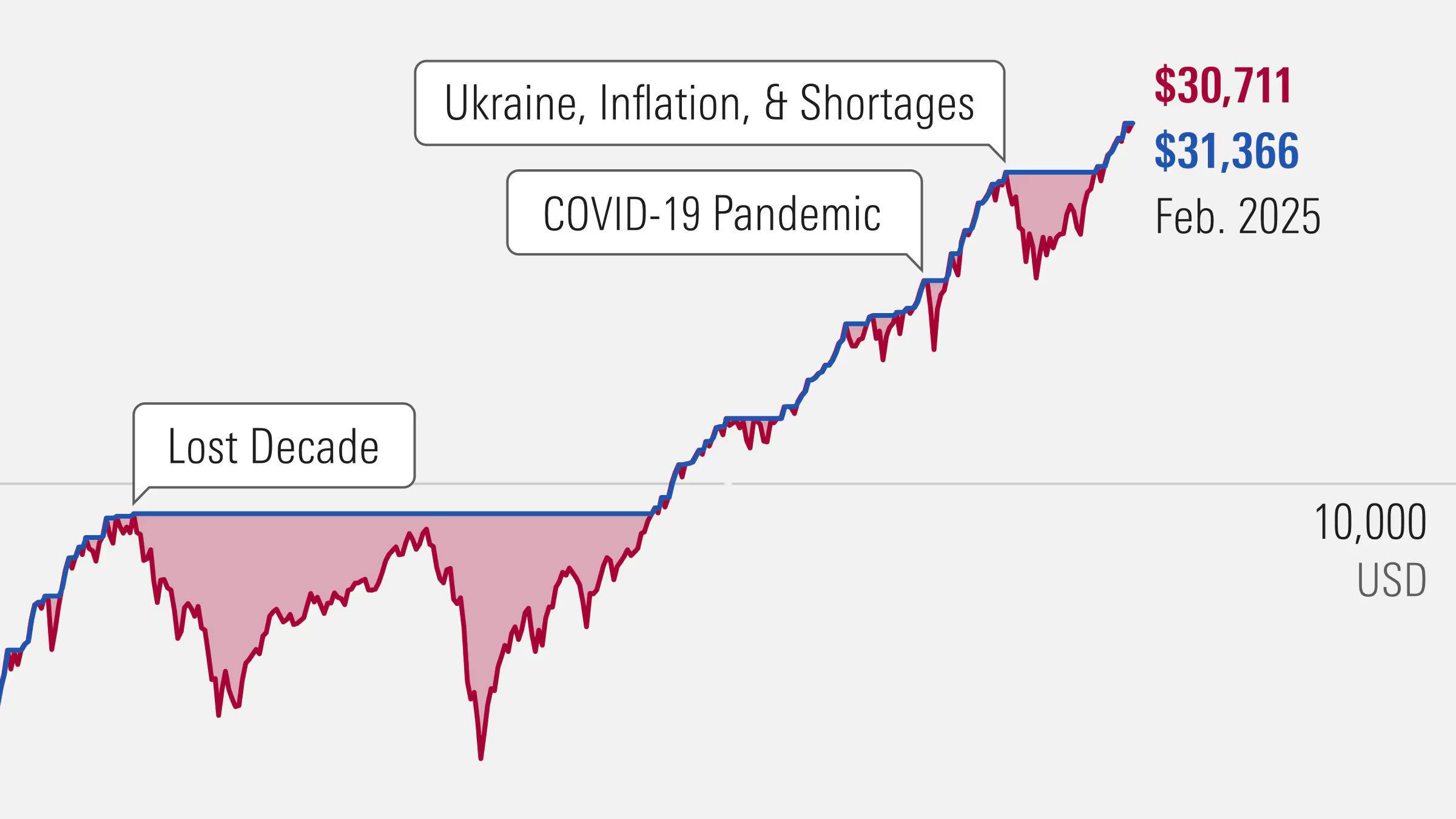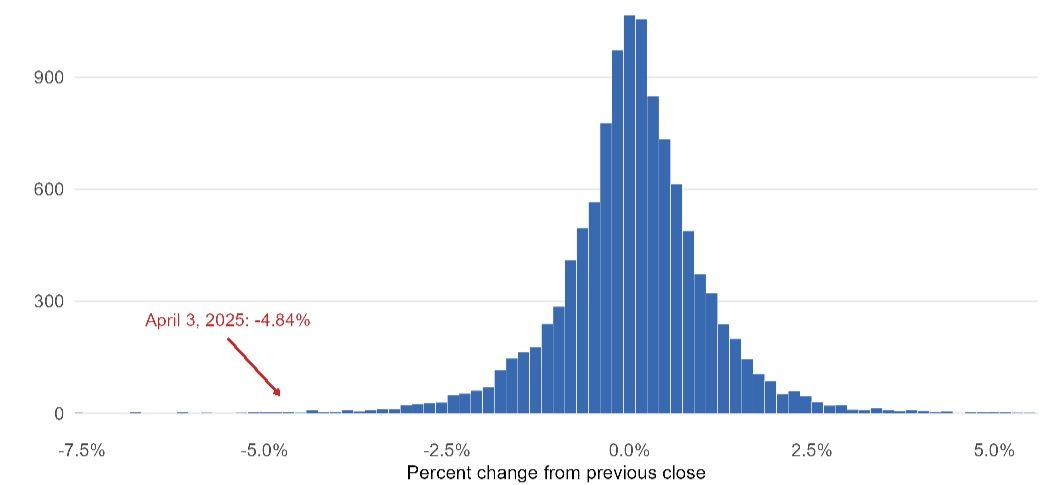What to do after a market drop?
This week, a new earthquake shook the financial markets. Donald Trump, now reelected and faithful to his hardline stance, announced a massive increase in tariffs on Chinese imports, triggering a shockwave across global markets. The S&P 500 lost more than 9% in a few days, while the NASDAQ erased several months of gains. Headlines are running wild.
Faced with this turbulence, our limbic brain screams panic. Yet, history teaches us another lesson. Let’s not ask the emotional question “Should we sell?”, but the rational one: “What do historical data reveal about these episodes of volatility?”
The paradox of markets: every crisis seems unique, but they all resemble each other
Just look back. For over 70 years, markets have been shaken by major crises: recessions, scandals, wars, pandemics… And yet, the S&P 500 has delivered an average return of 10% per year since 1950. Growth has never been linear, but it has always been resilient.

I compiled the major events of the last century and compared them with the evolution of the S&P 500. Every panic peak seemed to justify fleeing: the Vietnam War, the 1987 crash, the Lehman Brothers bankruptcy, Covid-19, and today… Trump’s tariffs.
But all these episodes, as dramatic as they were, become invisible in the long run.
This visual illustrates a fundamental truth: the short term is noisy, the long term is powerful.
Letting emotions dictate decisions is navigating blind. Having a long-term vision is staying the course, despite the waves.
Let’s not forget: the media are merchants of fear. Their sensationalist headlines boost their audience metrics. To each their own incentive.
The trap of market timing: when inaction costs more than mistakes
Many watch for “the right moment” to invest. It’s human. We want to avoid losses, buy at the lowest, sell at the highest. But this quest for perfect timing is an illusion. Markets are inherently unpredictable. Even professionals get it wrong.
If you had missed just the 10 best days in the stock market, your portfolio would have been cut in half. And these days often come right after the worst.
Striking example:
- March 16, 2020: The Dow Jones drops nearly 13%, one of the worst days in history.
- March 24, 2020: +2100 points on the Dow Jones, the biggest gain in 80 years.
Exiting the market after a drop often means missing the rebound. And this rebound is what makes all the difference. What paralyzes the investor is not lack of knowledge, but emotion: fear, regret, doubt. But the stock market doesn’t reward fear. It rewards discipline.
The probabilities of success: time as an ally

The longer your investment horizon, the closer your chances of loss get to zero. Investing is a game of duration, not timing. Those who win are those who stay.
Lump Sum or DCA: two strategies, one same destination
You’ve just received a significant sum: bonus, inheritance, asset sale.
“Should I invest everything now (Lump Sum) or go gradually (DCA)?”
The answer depends more on your psychology than the numbers.
Lump Sum
Investing all at once maximizes time in the market, hence the effect of compound returns.
Statistically, Lump Sum beats DCA because markets rise more often than they fall.
Every day out of the market is a day without growth.
But this requires high emotional tolerance. If the market drops after your investment, you must keep your cool.
DCA (Dollar Cost Averaging)
DCA consists of investing in regular installments—for example, $5,000 per month for 10 months.
This reduces stress, smooths the entry price, and defuses fear.
DCA doesn’t maximize gains, but it minimizes regrets.
It’s an excellent strategy for those hesitant to invest all at once.
The myth of the “lost decade”
With every market crisis, critics of index ETFs resurface. Their favorite example: the infamous “lost decade” of the 2000s, when the market took years to recover its highs.

To these detractors, let’s remind them that their scenario relies on biased assumptions:
- Single investment at the 2000 peak
- No subsequent contributions
- Dividends ignored
Who actually invests like that?
Comparison of Investment Strategies After the 2000 Crash
| Strategy | Investment Approach | Initial Capital | Dividend Reinvestment | Final Balance | Annualized Return (Nominal) | Real Return (After Inflation) |
|---|---|---|---|---|---|---|
| 1. Initial Capital + DCA | $10,000 initial + $400/month | $10,000 | ✅ Yes | $67,710 | +21.08% | +18.10% |
| 2. Initial Capital Only | Lump sum of $10,000 | $10,000 | ✅ Yes | $9,035 | -1.01% | -3.45% |
| 3. No Dividends | Lump sum of $10,000 | $10,000 | ❌ No | $7,587 | -2.72% | -5.12% |
Key Takeaways:
- Combined Approach Wins – The strategy combining an initial $10,000 investment with monthly $400 contributions grew to $67,710, despite the crash.
- Timing Matters – A single $10,000 investment at the market peak would have been worth only $9,035, even with dividends reinvested.
- Dividend Impact – Skipping dividend reinvestment led to an additional 16% decline ($9,035 → $7,587).
Analysis Period: March 2000 – 2009
Asset Class: S&P 500 (including dividend options)
Sources:
- Initial Capital + DCA Strategy
- Lump Sum at Peak + Dividend Reinvestment
- Lump Sum at Peak (No Dividends)
In reality, the “lost decade” only affected those who:
- Invested everything at once at the worst time
- Ignored dividends
- Didn’t take advantage of low prices to accumulate
Your anti-crisis checklist:
- Always reinvest dividends
- Maintain a steady investment flow (automated DCA)
Investor behavior matters more than timing.
Mini glossary: understanding CAGR
CAGR (Compound Annual Growth Rate) measures the annualized performance of an investment, accounting for compounding.
It’s the most reliable indicator for comparing performances across different periods.
The secret weapon: the magic of reinvested dividends
S&P 500 companies distribute dividends every year. By reinvesting them, you acquire more shares, amplifying future returns. Imagine a snowball growing as it rolls downhill: each reinvested dividend adds another layer.
Thus, the famous “7-year recovery post-2000” shrinks significantly with reinvested dividends.
Black swans: those rare days that hit hard

The chart above shows the distribution of daily S&P 500 returns since 1950.
Each bar represents how often the market recorded a given change. Most days cluster around 0% which is normal. But take a look at the far left tail of the distribution…
📉 On April 3, 2025, the market dropped by -4.84%.
That day falls into an extreme minority of days the kind we call “black swans”: rare, unpredictable events with massive impact.
The term comes from a long-standing belief in Europe that all swans were white until the discovery of black swans in Australia in the 17th century. This shock to conventional wisdom inspired author Nassim Taleb to use the phrase to describe events that defy expectations and only seem “obvious” in hindsight.
A black swan, according to Nassim Taleb, is an event that:
- Is rare and unexpected
- Has a massive impact
- Is rationalized after the fact as if it were predictable
These extreme days often driven by panic or euphoria are the exceptions that shape long-term returns. They may be invisible in annual averages, but they weigh heavily in compounded performance.
And most importantly: they strike without warning.
What to remember:
- Pulling out of the market “until things calm down” is often a mistake.
- Being invested during these rare days can make all the difference over 20 years.
Key takeaways
Yes, markets can stagnate for years. That’s normal.
This doesn’t invalidate index investing.
It simply means:
- Don’t invest in stocks for short-term goals (wedding, down payment, car).
- Adopt a minimum 10-year perspective.
- Accept that returns are not linear—they come in spurts.
Invest relentlessly
Markets waver, news scares, but the long term remains relentless. No matter the tariffs, wars, or viruses: wealth is built with consistency, not predictions.
Keep in mind:
- Crises are part of the game.
- Time in the market beats timing the market.
- Disciplined inaction outperforms rushed action.
Index investing isn’t a magic wand. It’s a robust method, designed to turn patience into wealth.
The worst investment choice is not investing at all.
 Buy me a coffee
Buy me a coffee